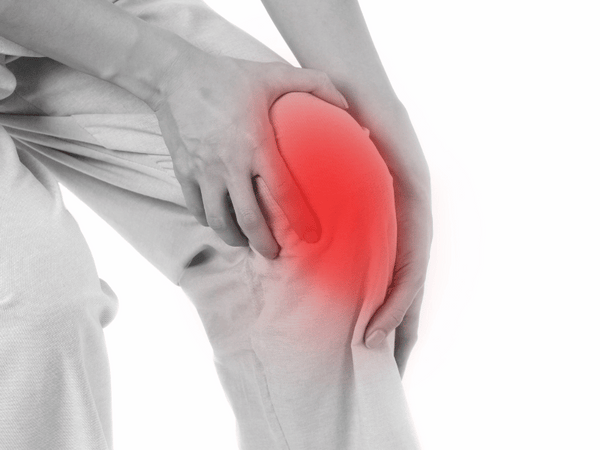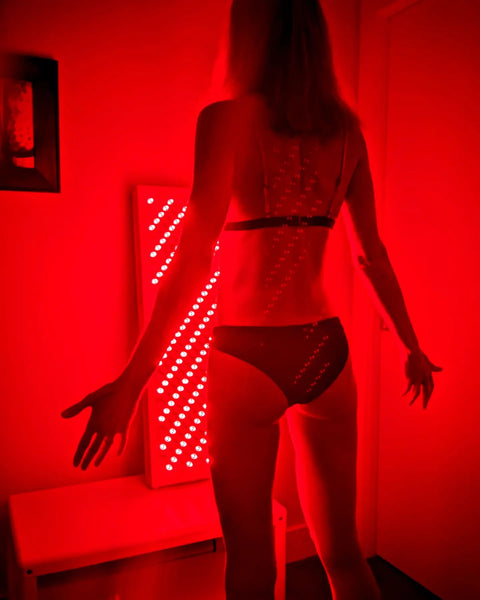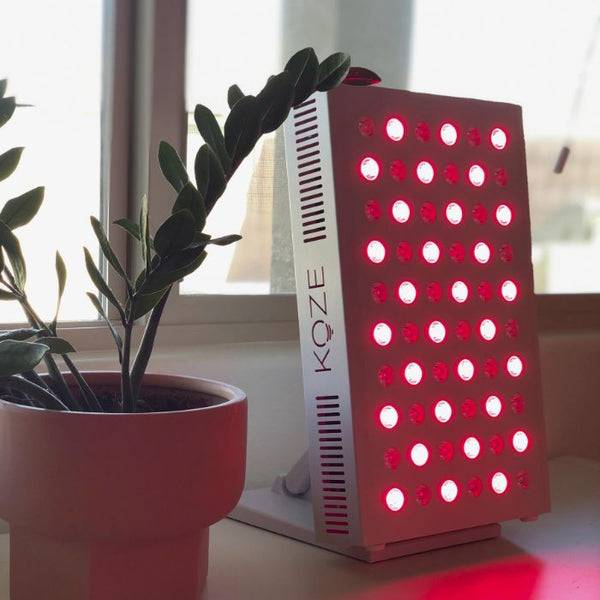
Red Light Therapy For Joint Pain Relief
Red Light Therapy For Joint Pain Relief
Joint pain is a common ailment affecting millions of people worldwide. Whether it stems from conditions like arthritis, injuries, or age-related wear and tear, joint pain can significantly impact one's quality of life. Finding effective, non-invasive methods to alleviate this pain is crucial for many. One such promising treatment is red light therapy.
Red light therapy, also known as low-level laser therapy (LLLT), involves using specific wavelengths of red light to penetrate the skin and stimulate cellular function. This therapy has gained popularity for its potential to reduce inflammation, relieve pain, and promote healing in various medical conditions, including joint pain.
How Does Red Light Therapy Help with Joint Pain?
Mechanisms of Red Light Therapy in Joint Pain Relief
Red light therapy has shown promise in alleviating joint pain level through several mechanisms. Understanding these mechanisms can help clarify how this non-invasive treatment can be so effective.
Cellular Level Impact
At the cellular level, red light therapy may impact joint pain by enhancing cellular function and energy production. Here’s how:
- Increased ATP Production: As mentioned earlier, red light therapy boosts the production of ATP in the mitochondria. This increase in cellular energy can accelerate the repair and regeneration of damaged tissues, including those in the joints.
- Enhanced Cellular Repair: The therapy promotes the synthesis of proteins and other essential molecules needed for cell repair. This helps in the quick recovery of damaged joint tissues.
Anti-inflammatory Effects
Inflammation is a major contributor to joint pain, particularly in conditions like arthritis. Red light therapy can significantly reduce inflammation through the following processes:
- Reduction of Inflammation Markers: Studies have shown that red light therapy can decrease the levels of pro-inflammatory cytokines, which are signaling molecules that promote inflammation. By reducing these markers, the therapy helps alleviate inflammation and associated pain.
- Increased Circulation: The therapy enhances blood flow to the treated area, which can help reduce inflammation and promote healing. Improved circulation brings more oxygen and nutrients to the joints, aiding in the reduction of swelling and pain.
Scientific Studies Supporting Anti-inflammatory Benefits
- A 2009 study published in "Lasers in Surgery and Medicine" found that red light therapy significantly reduced inflammation in subjects with arthritis.
- Another study in the "Journal of Photochemistry and Photobiology" (2014) reported that red light therapy reduced inflammation and improved joint mobility in rats with induced arthritis.
Pain Reduction
Red light therapy is also effective in reducing the sensation of pain itself. Here’s how:
- Endorphin Release: The therapy can stimulate the release of endorphins, which are natural pain-relieving hormones. This can provide immediate relief from joint pain.
- Modulation of Pain Pathways: Red light therapy can influence the nervous system’s pain pathways, potentially reducing the transmission of pain signals to the brain.
Clinical Trials on Pain Reduction
- A 2015 randomized controlled trial published in "Photomedicine and Laser Surgery" found that patients with chronic joint pain experienced significant pain relief after several sessions of red light therapy.
- Another trial in "Clinical Rheumatology" (2017) showed that red light therapy reduced pain and improved function in patients with knee osteoarthritis.
Benefits of Red Light Therapy for Joint Pain Relief
Key Benefits of Using Red Light Therapy
Red light therapy offers several key benefits for those suffering from joint pain. This non-invasive treatment provides a safe and effective alternative to traditional pain relief methods. Let’s explore the main advantages:
Non-invasive and Painless
One of the most significant benefits of red light therapy is that it is non-invasive and painless. Unlike surgical procedures or injections, red light therapy does not require any incisions or physical interventions. This makes it an attractive option for those seeking pain relief without the risks and recovery time associated with more invasive treatments.
- No Needles or Surgery: Red light therapy is applied externally, so there's no need for needles or surgical procedures.
- Minimal Discomfort: Most users experience no discomfort during or after the treatment, making it suitable for all ages.
Safe with Minimal Side Effects
Red light therapy is generally considered safe with minimal side effects. It is well-tolerated by most individuals and does not carry the risks associated with long-term use of pain medications.
- Low Risk of Adverse Effects: Side effects are rare and usually mild, such as temporary redness or warmth in the treated area.
- No Risk of Addiction: Unlike opioid medications, red light therapy does not pose a risk of addiction or dependence.
Promotes Healing and Recovery
Beyond pain relief, red light therapy also promotes healing and recovery. It helps repair damaged tissues and enhances overall joint function.
- Enhanced Tissue Repair: The increased ATP production and improved cellular function help repair damaged joint tissues more effectively.
- Faster Recovery: Regular use of red light therapy can speed up recovery times, allowing individuals to return to their normal activities sooner.
Specific Benefits Supported by Research
Reduction in Pain and Disability
- A study in "Pain Research and Management" (2017) found that patients with knee osteoarthritis experienced significant reductions in pain and disability after red light therapy sessions.
- Another study in "Lasers in Medical Science" (2018) reported improved pain scores and physical function in patients with chronic joint pain.
Improvement in Joint Mobility
- Research published in "Clinical Rheumatology" (2015) showed that red light therapy improved joint mobility and reduced stiffness in patients with rheumatoid arthritis.
- A trial in "Journal of Orthopaedic Research" (2016) found that red light therapy enhanced range of motion and flexibility in individuals with joint wrap injuries.
What is Red Light Therapy?
Overview of Red Light Therapy
Red light therapy is a form of phototherapy that uses low-intensity red and near-infrared light to treat various medical conditions. This therapy dates back to the early 20th century, but it has seen significant advancements in recent decades, making it a popular non-invasive treatment option today.
How Red Light Therapy Works
Red light therapy operates on the principle that specific wavelengths of light can penetrate the skin and influence cellular function. Here's a detailed look at how it works:
- Penetration of Light: Red light typically falls within the wavelength range of 630 to 700 nanometers (nm), while near-infrared light ranges from 800 to 900 nm. These wavelengths are capable of penetrating the skin to a depth of about 5 to 10 millimeters.
- Cellular Impact: Once the light penetrates the skin, it is absorbed by the mitochondria in the cells. The mitochondria are the powerhouse of the cell, responsible for producing energy in the form of adenosine triphosphate (ATP).
- Increased ATP Production: The absorbed light energy stimulates the mitochondria to produce more ATP. Increased ATP production enhances cellular energy and accelerates the body's natural healing processes.
Types of Red Light Therapy Devices
There are various devices available for red light therapy, each designed for specific applications. Common types include:
- Handheld Devices: These are portable and convenient, making them ideal for targeted treatment of specific areas, such as joints.
- Panels: Larger panels are suitable for treating broader areas of the body simultaneously. They are often used in professional settings or for home use with larger treatment goals.
- Beds and Wraps: These devices provide full-body treatment, commonly found in clinics and wellness centers.
Historical Background
Red light therapy has its roots in the early experiments with phototherapy by Niels Ryberg Finsen, who won the Nobel Prize in Medicine in 1903 for his work on treating skin diseases with light. Since then, extensive research and technological advancements have expanded its applications, particularly in pain management and healing.
Specific Conditions Treated by Red Light Therapy
Conditions That Benefit from Red Light Therapy

Red light therapy has shown promise in treating various conditions that cause joint pain. Let's delve into some specific conditions and how red light therapy can provide relief.
Osteoarthritis
Osteoarthritis is a degenerative muscle and joint disease characterized by the breakdown of cartilage, leading to pain, stiffness, and reduced mobility. It commonly affects the knees, hips, hands, and spine.
- Symptoms and Challenges: Individuals with osteoarthritis experience joint pain, stiffness, swelling, and a decreased range of motion. Daily activities like walking, climbing stairs, or even gripping objects can become challenging.
- Effectiveness of Red Light Therapy for Arthritis: Studies have shown that red light therapy can reduce pain and improve joint function in osteoarthritis patients. By decreasing inflammation and promoting cartilage repair, red light therapy helps alleviate symptoms and improve the quality of life for those affected.
Research Supporting Red Light Therapy for Osteoarthritis:
- A 2015 study published in "Photomedicine and Laser Surgery" demonstrated that patients with knee osteoarthritis experienced significant pain reduction and improved joint function after red light therapy.
- Another study in "Lasers in Surgery and Medicine" (2017) found that red light therapy effectively reduced inflammation and improved mobility in individuals with hand osteoarthritis.
Rheumatoid Arthritis
Rheumatoid arthritis (RA) is an autoimmune disease where the immune system attacks the synovium (lining of the joints), causing inflammation, pain, and joint damage.
- Symptoms and Challenges: RA leads to painful, swollen, and stiff joints, often in the hands, wrists, and knees. It can also cause fatigue and systemic symptoms affecting the entire body.
- Impact of Red Light Therapy on RA: Red light therapy helps reduce inflammation and pain in RA patients. It can slow down the progression of joint damage and improve overall joint health.
Scientific Evidence on Red Light Therapy for RA:
- A 2014 study in the "Journal of Photochemistry and Photobiology" reported that red light therapy reduced inflammation and pain in RA patients, leading to improved joint function.
- Another clinical trial published in "Clinical Rheumatology" (2016) showed that red light therapy decreased pain and stiffness in RA patients, enhancing their quality of life.
Tendinitis
Tendinitis is the inflammation of a tendon, often caused by overuse or repetitive strain. Commonly affected areas include the shoulders, elbows, wrists, and knees.
Common Tendinitis Conditions:
- Tennis Elbow: Chronic pain and inflammation in the elbow tendons due to repetitive arm motions.
- Achilles Tendinitis: Inflammation of the Achilles tendon, causing knee pain heel pain.
- Rotator Cuff Tendinitis: Shoulder pain and stiffness due to inflamed rotator cuff tendons.
- How Red Light Therapy Helps: Red light therapy reduces inflammation and promotes healing in the affected tendons. It also enhances collagen production, which is crucial for tendon repair.
Bursitis
Bursitis is the inflammation of the bursae, small fluid-filled sacs that cushion the joints. It commonly affects the shoulders, elbows, hips, and knees.
- Symptoms and Challenges: Bursitis causes joint pain, swelling, and tenderness. Movement of the affected joint becomes painful and restricted.
- Effectiveness of Red Light Therapy for Bursitis: Red light therapy helps reduce inflammation and pain in bursitis patients. It accelerates the healing process and improves joint mobility.
Studies on Red Light Therapy for Bursitis:
- A 2016 study in "Lasers in Medical Science" showed that red light therapy reduced pain and improved mobility in patients with shoulder bursitis.
- - Another study in "Clinical Interventions in Aging" (2018) reported that red light therapy effectively alleviated symptoms of hip bursitis, enhancing the quality of life for patients.
FAQs about Red Light Therapy for Joint Pain Relief
Is Led Light Therapy Safe for Everyone?
Infrared light therapy is generally considered safe for most people, including those with chronic conditions and older adults. However, there are a few considerations to keep in mind:
- Contraindications: Individuals with certain medical conditions, such as severe photosensitivity, should consult with their healthcare provider before starting red light therapy. Additionally, those who are pregnant or have a history of skin cancer should seek medical advice.
- Side Effects: Side effects are rare and typically mild. Some users might experience temporary redness or warmth in the treated area. It is crucial to follow the manufacturer’s instructions and not exceed the recommended usage times.
How Quickly Can I Expect to See Results?
The timeframe for results can vary based on several factors, including the severity of the condition, the frequency of treatment, and individual response to therapy:
- Immediate Relief: Some users report experiencing immediate relief from pain and inflammation after the first few sessions.
- Long-term Improvement: For chronic conditions, it might take several weeks of consistent use to see significant improvements. Studies suggest that most users start noticing substantial benefits after 4 to 8 weeks of regular treatment.
Can I Use Red Light Therapy in Conjunction with Other Treatments?
Yes, red light therapy can be used alongside other treatments for joint pain relief. It is often integrated into a comprehensive treatment plan to enhance overall effectiveness:
- Complementary Therapies: Red light therapy can be used in conjunction with physical therapy, medications, and other pain relief methods. It helps reduce inflammation and pain, allowing other treatments to be more effective.
- Consult Your Doctor: Always consult with your healthcare provider before combining treatments to ensure there are no potential interactions or contraindications.
Are There Any Side Effects?
Red light therapy is associated with minimal side effects, making it a safe option for most individuals:
- Common Side Effects: The most common side effects are mild and include temporary redness, warmth, or a tingling sensation in the treated area.
- Rare Side Effects: In rare cases, overuse or improper application of the therapy can lead to skin irritation. Following the recommended guidelines and using the therapy as directed can prevent these issues.
How Do I Maintain My Device?
Maintaining your red light therapy device is essential to ensure its longevity and effectiveness. Here are some tips for proper maintenance:
- Cleaning: Regularly clean the surface of the device with a soft, damp cloth. Avoid using harsh chemicals or abrasive materials that could damage the light-emitting diodes (LEDs).
- Storage: Store the device in a cool, dry place away from direct sunlight. Ensure it is kept out of reach of children and pets to prevent accidental damage.
- Usage Guidelines: Follow the manufacturer's instructions for usage and maintenance. Adhering to these guidelines will help preserve the device’s functionality and ensure safe and effective treatments.
Conclusion
Final Thoughts on Red Light Therapy for Joint Pain Relief
Red light therapy offers a powerful, non-invasive option for alleviating joint pain from conditions like osteoarthritis, rheumatoid arthritis, tendinitis, and bursitis. It is a safe and effective alternative to traditional pain relief methods, backed by scientific research and positive user testimonials.
Key Benefits Recap:
- Non-invasive and Painless: No need for surgery or injections, and well-tolerated with minimal discomfort.
- Safe with Minimal Side Effects: Low risk of adverse effects, suitable for most individuals.
- Promotes Healing and Recovery: Enhances cellular function, reduces inflammation, and accelerates tissue repair.
- Effective for Various Conditions: Proven to provide significant relief for multiple joint-related conditions.
By increasing ATP production, reducing inflammation markers, and modulating pain pathways, red light therapy addresses both the symptoms and underlying causes of joint pain, enhancing joint function and promoting overall healing.
Consult with Healthcare Professionals: Before starting red light therapy, consult with a healthcare professional to ensure it is appropriate for your condition and needs. They can provide personalized advice and help integrate this therapy into your treatment plan.
Final Remarks:
Red light therapy is a promising solution for joint pain relief, offering hope and improved quality of life for many. As research continues, more individuals can benefit from this innovative and effective treatment.



